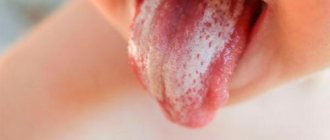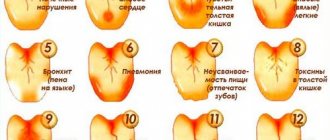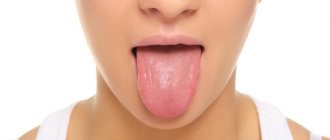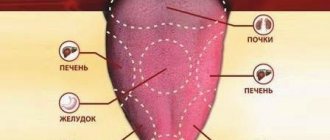Treatment of white plaque on a child’s tongue
A white coating on a child’s tongue is most likely ordinary food debris. If it is not removed with a damp cloth and spreads to the mucous membrane of the cheeks, then this indicates the development of an infectious process.
Why does a white coating appear on the tongue of a baby during breastfeeding? As a rule, this is thrush - a fungal infection caused by yeast-like fungi belonging to the genus Candida. A white coating covers the baby's tongue and gums, the inside of the lips and cheeks. Thrush often occurs in children under one year of age. The reason is the immature immune system of infants. Thrush is a contagious disease, so to avoid it, bottles and pacifiers must be thoroughly sterilized. Older children also get thrush. Children with weakened immune systems and asthmatic children using inhaled corticosteroids are at risk. Treatment of white plaque on a child's tongue is carried out with local antifungal drugs. Important: medications should be prescribed exclusively by a doctor, since a similar picture may be a symptom of another condition in which antifungal drugs are not required. For example, diseases caused by the Coxsackie virus are often accompanied by the appearance of white “spots” on the tongue. In fact, these are painful ulcerations that disappear on their own within 3-5 days without any treatment. Therefore, if you find a white coating on your child’s tongue, you should consult a doctor and not self-medicate.
In infants, the surface of the tongue may be covered with a colored coating. How to treat a yellow coating on the tongue of a newborn depends on the condition that is accompanied by this symptom. For example, sometimes the tongue becomes coated with a colored coating from certain baby formulas. Just change your diet and your tongue will clear up. However, yellow plaque may also indicate problems with the gastrointestinal tract and respiratory infections. In these cases, treatment of the underlying disease is carried out.
Acute herpetic stomatitis
This is an infectious viral disease that occurs in response to primary contact with the herpes simplex virus.
Infection occurs
- by airborne droplets;
- through contact and household means (through toys, dishes, etc.);
- from persons suffering from recurrent herpes.
Children aged 6 months to 3 years are most often affected.
Main signs of the disease:
redness of the oral mucosa and blisters appear, which quickly open and form multiple painful round ulcers (erosions), bleeding gums; increased body temperature, general weakness, intoxication; the child eats and sleeps poorly.
To prevent the spread of infection
a child with acute herpetic stomatitis is not allowed to visit a child care facility, even if the disease occurs in a very mild form.
Prevention of infection with the herpes simplex virus upon contact with sick people involves lubricating the mucous membrane of the nose and mouth with 0.25% oxolinic ointment for 5 days.
If there are signs of disease, you should consult a pediatric dentist!
Causes of black plaque on the tongue in adults
“Stick out your tongue” - probably everyone has heard this phrase in the doctor’s office. “Why is it so important for a doctor to see a patient’s tongue?” – patients are lost in conjecture. The doctor will determine whether the tongue is clean or coated, and can suggest a diagnosis based on the nature and color of the plaque. Dark coating on the tongue is a sign of what disease? Do not be afraid of the appearance of a strange shade of the mucous membrane of the tongue. The reasons for the color change may be temporary and completely harmless.
Causes of black plaque on the tongue in adults:
- changes in bacterial flora after a course of antibiotics;
- poor oral hygiene;
- xerostomia;
- glossitis;
- regular use of mouthwashes containing irritating oxidizing agents;
- smoking or chewing tobacco;
- drinking excessive amounts of coffee or black tea;
- alcohol abuse.
What does brown coating on the tongue mean? Discoloration usually occurs when the papillae on the surface of the tongue grow larger than normal. The waste products of microorganisms accumulate between them, which leads to an unpleasant tint of the tongue. If the root of the tongue is covered with a green coating, the cause may be oral candidiasis (thrush). When taking antibiotics or eating “colored” foods, the white-gray coating characteristic of thrush can turn different shades of green.
What does a red coating on the tongue mean:
- about a lack of folic acid and vitamin B12, which causes a reddish tint;
- about “geographic tongue” (benign migratory glossitis), which is characterized by the appearance of reddish spots on the surface of the tongue;
- about scarlet fever, one of the symptoms of which is “strawberry tongue.” Read more about the symptoms and treatment of scarlet fever on our website Dobrobut.com;
- about Kawasaki syndrome, observed in children under the age of five and characterized by damage to the blood vessels. The syndrome is accompanied by redness of the tongue (“strawberry tongue”).
Chronic recurrent aphthous stomatitis
This is a chronic inflammatory disease of the oral mucosa of a non-infectious nature, characterized by periodic exacerbations and remissions.
Causes of the disease:
- allergic reactions in a child;
- diseases of the gastrointestinal tract;
- respiratory infections;
- functional disorders of the central and autonomic nervous system;
- chronic inflammatory diseases of the nasopharynx (otitis, sinusitis, etc.)
School-age children and adolescents are more often affected.
Main signs of the disease:
on the mucous membrane of the oral cavity (usually lips, cheeks, transitional folds of the upper and lower jaws, the lateral surface and back of the tongue) one or several areas of redness with rounded painful aphthae covered with a yellowish coating appear; the child’s general condition may deteriorate, the child refuses to eat; healing occurs with adequate treatment after 5-7 days without a scar.
In order to prevent exacerbations of the disease, it is necessary:
- regular visits to the dentist (at least 2 times a year);
- elimination of foci of chronic infection in the oral cavity (treatment of carious teeth and periodontal diseases);
- systematic hygienic oral care.
If there are signs of disease, you should consult a pediatric dentist!
How to deal with tongue coating
Thorough cleaning of the tongue is the main hygienic measure aimed at eliminating plaque. Clinical trials have shown that regular tongue cleaning reduces bacteria and bad odor by 75%.
How to get rid of dry mouth and white coating on the tongue:
- use a special scraper - effective tongue cleaning reduces plaque by 40%;
- drink enough water;
- eat foods containing coarse fiber (for example, apples, carrots);
- quit smoking;
- do not abuse alcoholic beverages;
- Healthy food;
- rinse your mouth after eating.
By following these simple rules, you can forever “say goodbye” to the coating on your tongue and forget about bad breath.
Related services: Pediatrician consultation
Afta Bednara
This is an inflammatory disease of the oral mucosa of a non-infectious nature, occurring in weak, bottle-fed infants in the first months of life.
Causes of the disease:
- permanent mechanical injury to the mucous membrane of the palate due to a nipple that is too long and too hard;
- may occur in breastfed children if the mother's nipple is very rough.
Main signs of the disease:
round or oval erosions, covered with loose plaque and located symmetrically at the border of the hard and soft palate, redness of the surrounding mucous membrane. The child becomes restless, eats and sleeps poorly.
In order to prevent the occurrence of the disease, it is necessary
promptly replace the pacifier or pacifier if irritation occurs on the oral mucosa.
If there are signs of disease, you should consult a pediatric dentist!
If any changes appear on the oral mucosa, you should visit a pediatric dentist to avoid complications and conduct a comprehensive examination and treatment!!!
Causes of plaque
Factors that provoke the appearance of light masses can also be diseases. The reasons for the appearance of a white coating on a child’s tongue often arise due to disturbances in the functioning of the body. It is very difficult, almost impossible, to remove such dense layers.
- The surface of the muscular organ suffers when hygienic manipulations of the oral cavity are violated;
- A light film covers the mucous membranes when taking certain types of medications;
- Excessive development and active reproduction of pathogenic microflora has a detrimental effect on the health of the oral cavity, so there may be a white coating on the tongue of a newborn;
And this is only a small part of those aspects that have a bad effect on the health of the mucous membranes. If symptoms of plaque appear, a small child should be shown to a local pediatrician. This is the only way to accurately determine the factors that provoked the appearance of deposits. By the way, a child may not only have a dry and burning mouth, but also a high body temperature. Often a plaque with red spots is diagnosed, which in medicine is called geographic tongue. In any case, self-medication is prohibited. Contact your pediatrician, he will competently develop a therapeutic program.
Inflammatory processes
Often a baby will develop a white coating on the tongue due to stomatitis. The symptoms of the disease are very unpleasant. The disease is characterized by deposits that have a heterogeneous structure. Whitish grains are clearly visible on the muscle organ. If you try to eliminate them, blood is released. The baby is irritable and suffers from burning and pain in the mouth, as there are ulcers on the surface of the tongue.
At 3 years of age and earlier, as a rule, stomatitis of candidal origin. Light layers are present on the cheeks, gums, and even on the lips. The pain intensifies when eating sour-tasting foods. A visit to a medical facility is mandatory. Therapy consists of anti-inflammatory and painkillers that are used to treat the affected areas.
Fungal diseases
If the treatment of baby teeth is not carried out in a timely manner, this leads to the active proliferation of pathogenic microflora, including fungi. A white film on the lips and tongue often indicates that the baby has thrush (another name for candidiasis). In babies:
- the oral mucosa turns red;
- dryness appears;
- discomfort;
The younger the children, the worse they tolerate the disease. A one-year-old child becomes very capricious, he refuses to eat. Removing the film causes bleeding. The mucous membranes become covered with plaques and papules. To alleviate the condition, remove severe burning and itching, make an appointment with a pediatrician.
Caries
With caries, a dense white mass can form on the muscular organ and in the oral cavity. It doesn’t matter whether the child is 10 years old or a baby with baby teeth. This is due to the fact that the disease in its advanced form is a source of infection. Pathogenic bacteria thrive in the whitish mass on the tongue. They actively reproduce and aggravate the situation.
At 2 years old, when the baby has unstable teeth, parents should also monitor the oral cavity and prevent carious lesions on the units. Preventing the disease is possible. It is necessary to observe the rules of oral hygiene, and regularly. This is the only way that unwanted microorganisms will not settle on the mucous tissues of the tongue and a film will not form from the products of their vital activity.
Pathologies of the respiratory systems
If the tongue is covered with a white coating, this may indicate problems in the airways. Can be diagnosed:
- Viral form of the disease;
- Diseases of a bacterial nature;
With the flu or acute respiratory infections, the temperature rises, the throat turns red, a cough appears, and the tongue becomes covered with a whitish film. A sign of pharyngitis and tonsillitis is the covering of not only the tongue, but also the tonsils with white masses. Clumps on the tip of the tongue indicate bronchitis. Deposits with a foamy consistency indicate chronic bronchitis.
Infectious diseases
When an infection enters the body, the body defends itself by raising body temperature. In this case, whitish masses of dense and thick consistency often form on the muscular organ. With scarlet fever, reddish islands are visible on the white tongue. The tonsils and the root of the tongue are covered with a particularly thick coating. Severe intoxication is detected in the child’s body.
Diphtheria affects different areas of the oral cavity. It is not uncommon for a child to develop gum inflammation. There are dots with a white tint on the tonsils, and light grayish deposits on the tongue. Remember that the formation of pus requires an immediate trip to the doctor.
Gastrointestinal diseases
When bottle-fed, formula often leaves a slight residue, which is not dangerous for the baby. But it happens that quite serious diseases develop from such food:
- The film in the central zone of the muscular organ and the formation of cracks and grooves indicate gastritis.
- A one-month-old baby is more susceptible to dysbiosis than others, since his digestive system has not yet been adjusted. In such a situation, the tongue is completely covered with whitish masses.
- At the age of 7, when hormonal changes begin and baby teeth are replaced by permanent ones, children are susceptible to enterocolitis. Inflammation in the intestines leads to deposits on the back of the tongue.











